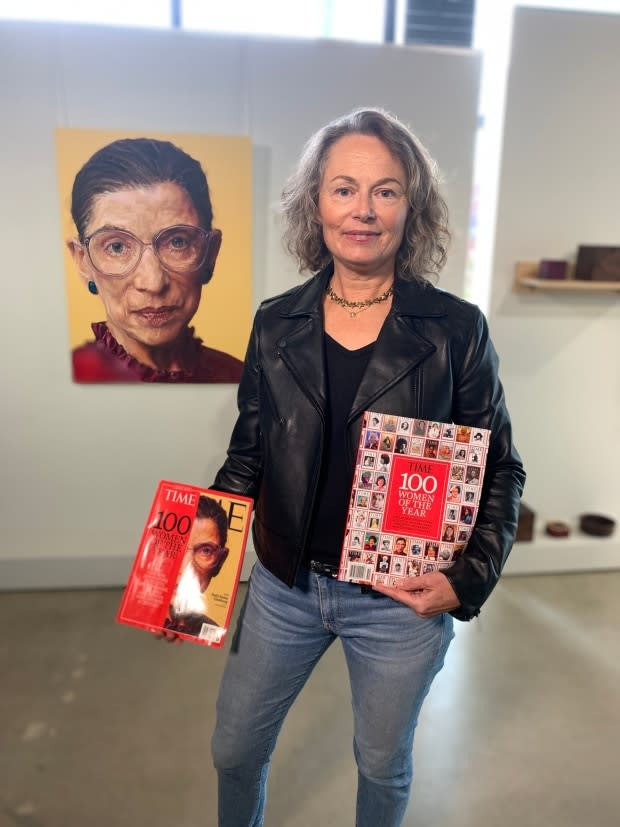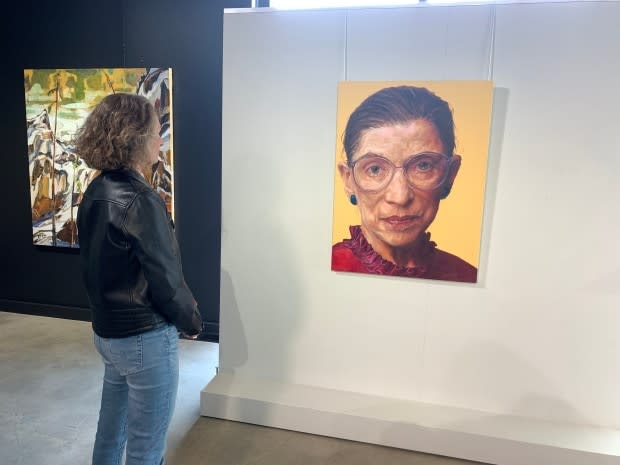How Edmonton artist came to paint Ruth Bader Ginsburg's portrait for Time
Shana Wilson's cellphone lit up with text messages on Friday night following news of the death of U.S. Supreme Court Justice Ruth Bader Ginsburg, 87.
The Edmonton artist did not know Ginsburg personally, but she has a connection to the women's rights champion having painted a portrait of her for the March issue of Time magazine.
"Just to be the tiniest part of her extraordinary legacy that she has left for us to all carry on is honestly the most humbling thing in my entire life," Wilson told CBC News on Monday.
In October 2019, Wilson staged an exhibition called For Women Who Roar at the Vignettes Design and Arts Festival in Edmonton.
For the show, Wilson produced 15 large portraits of trailblazing women, including Gloria Steinem, Buffy Sainte-Marie and Serena Ryder. The exhibition brought the oil painter a wave of publicity and exposure, particularly on social media.
A few months later, on a cold day in January, Wilson was painting in her studio when she stopped for a break to check her email. She was shocked to find a message from D.W. Pine, the creative director at Time.
Wilson, who subscribes to the magazine, almost overlooked the email, which had "A message from Time" in the subject line.
Pine told Wilson that he had discovered her work online and had since become a big fan.
LISTEN | Ginsburg portrait artist remembers:
He invited her to contribute to a special issue of the magazine honouring influential women who had been overshadowed during the past century. (Time named a Man of the Year for decades before changing its annual award to Person of the Year in 1999.)
Wilson said she was excited but overwhelmed by the opportunity; she sobbed after learning in another email that her subject would be Ginsburg.
"She's been an icon of mine for so long," she said.
Ginsburg is best known for her 27 years on the U.S. Supreme Court, but she fought for women's rights before landing a seat on the bench.
In 1971, while working for the American Civil Liberties Union, she wrote the plaintiff's brief in Reed vs. Reed, a Supreme Court case about the validity of an Idaho law that preferred fathers over mothers serving as estate administrators.
Applying the Equal Protection Clause of the 14th Amendment, the Supreme Court declared the law unconstitutional. The case opened the door for similar legal challenges.
"It occurred to me while I was painting that, had she not had the law passed back in the '70s that made it illegal to discriminate on the basis of gender, I, as a woman, wouldn't even be painting a front cover for Time magazine," Wilson said.
'Have to do her justice'
In an interview on Monday with CBC's Rod Kurtz, Wilson said the significance of that history added pressure to the painting process.
"I have to do her justice — no pun intended — I have to nail this portrait," she recalled thinking at the time.
While watching the 2018 documentary RBG, Wilson said she was so overwhelmed by Ginsburg's importance that she could not finish the film.
Wilson had three weeks to produce the portrait for Time, and she submitted daily photographs showing her progress.
Two weeks in, based on the strength of those photos, she was asked to paint a second portrait — of Jackie Kennedy — for the magazine. After many late nights, Wilson finished both pieces before the deadline.
Her portraits were two of 10 featured on the cover of the magazine's print edition.
Edmonton artist Lauren Crazybull also contributed to the project with a portrait of Wilma Mankiller, the first woman elected as principal chief of the Cherokee Nation.
Time's special issue, which came out in early March, coincided with the 100th anniversary of women's suffrage in the United States and International Women's Day.
The magazine also published a special print edition, on shelves now, featuring all 100 covers designed for the project. A page in that issue includes a picture of Wilson painting her Ginsburg portrait.

Legacy of empathy
Wilson said she plans to honour Ginsburg's legacy by continuing to paint portraits that empower women and their accomplishments.
For too long, women have been either objectified or absent from gallery walls, she said.
When she considers Ginsburg's contributions, she thinks about the relationship between empathy, justice and equality.
"To me, that is her legacy," Wilson said.
"The most important thing we can do right now is to use our voices and our actions to carry her torch."
Wilson's portrait of Ginsburg can be seen in the Peter Robertson Gallery at the corner of 124th Street and 104th Avenue in Edmonton.



